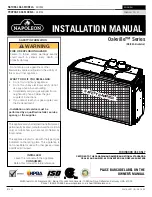
FOCUS ST Owner's Manual
16
RSF Woodburning Fireplaces
Some local codes require that the walls be insulated,
vapor sealed and sheathed with a fire rated gypsum
board (see Figure 11). We strongly recommend this
procedure for all installations to prevent cold drafts from
originating in the fireplace enclosure. If you follow this
procedure, we recommend that you do not insulate the
wall above the front of the fireplace.
REMEMBER:
Check local codes concerning
installation requirements and restrictions in your area.
MASONRY CHIMNEY
Installing your FOCUS ST fireplace with a masonry
chimney still requires using EXCEL chimney from the
top of the fireplace to where it will connect to a listed
liner that will run up inside the masonry chimney (see
Figure 12).
The stainless-steel liner should be fitted inside the clay
liner all the way to the top of the masonry chimney. It is
not meant to replace the clay liner. You can use either
the EXCEL liner or any other listed liner to ULC-S635,
ULC-S640 or UL-1777.
Special care is to be taken to make sure that you have
a good solid connection between the EXCEL chimney
and the liner. A masonry adapter (FO-FDM8) was
designed specifically for that purpose and is available
from your RSF dealer. It will attach to the liner with 3
stainless steel rivets (provided) and to the EXCEL
chimney with 3 screws (provided).
After mortaring in place, the connection between the
EXCEL chimney and the liner should not be visible in
order to isolate the heat released through the liner from
the fireplace enclosure.
As depicted in Figure 12, you must install at least one 18" length of EXCEL chimney after the EXCEL chimney
elbow. The uppermost part of the EXCEL chimney - where it enters the masonry chimney - must be a minimum of
12" from the ceiling.
NOTE:
If the ceiling is high enough, you can install one or more EXCEL chimney lengths directly on the fireplace
before the elbow.
If you use a flexible liner, make sure to be careful when cleaning to ensure that the stainless-steel flexible liner is
not dislodged in any way.
Using an Existing Masonry Chimney
❖
WARNING: IF YOU ARE CONSIDERING USING AN EXISTING CHIMNEY, IT MUST FIRST BE
THOROUGHLY INSPECTED BY AN AUTHORITY HAVING JURISDICTION TO DETERMINE THE FOLLOWING:
1. The masonry chimney is well constructed and fully lined, in accordance with Local Building Codes and the
National Building Code of Canada (NBC) or National Fire Protection Association chimney standard (NFPA 211).
2. It has been thoroughly cleaned of any soot or creosote residue and inspected to determine that it is in good
working condition.
3. There is no insulation of any type in contact with the masonry chimney and there is no insulation stuffed
anywhere in the chimney.
4. All the necessary clearances around the masonry chimney, along the complete run of the chimney, are
respected as per NBC or NFPA 211. If the masonry chimney is enclosed in drywall, openings will probably be
required in order to verify clearances at all points.
5. The masonry chimney will only be used for the fireplace and no other appliance.
* Refer to the text to determine the appropriate flashing
Figure 11 Chimney Installed with a Chase
Enclosure Example









































